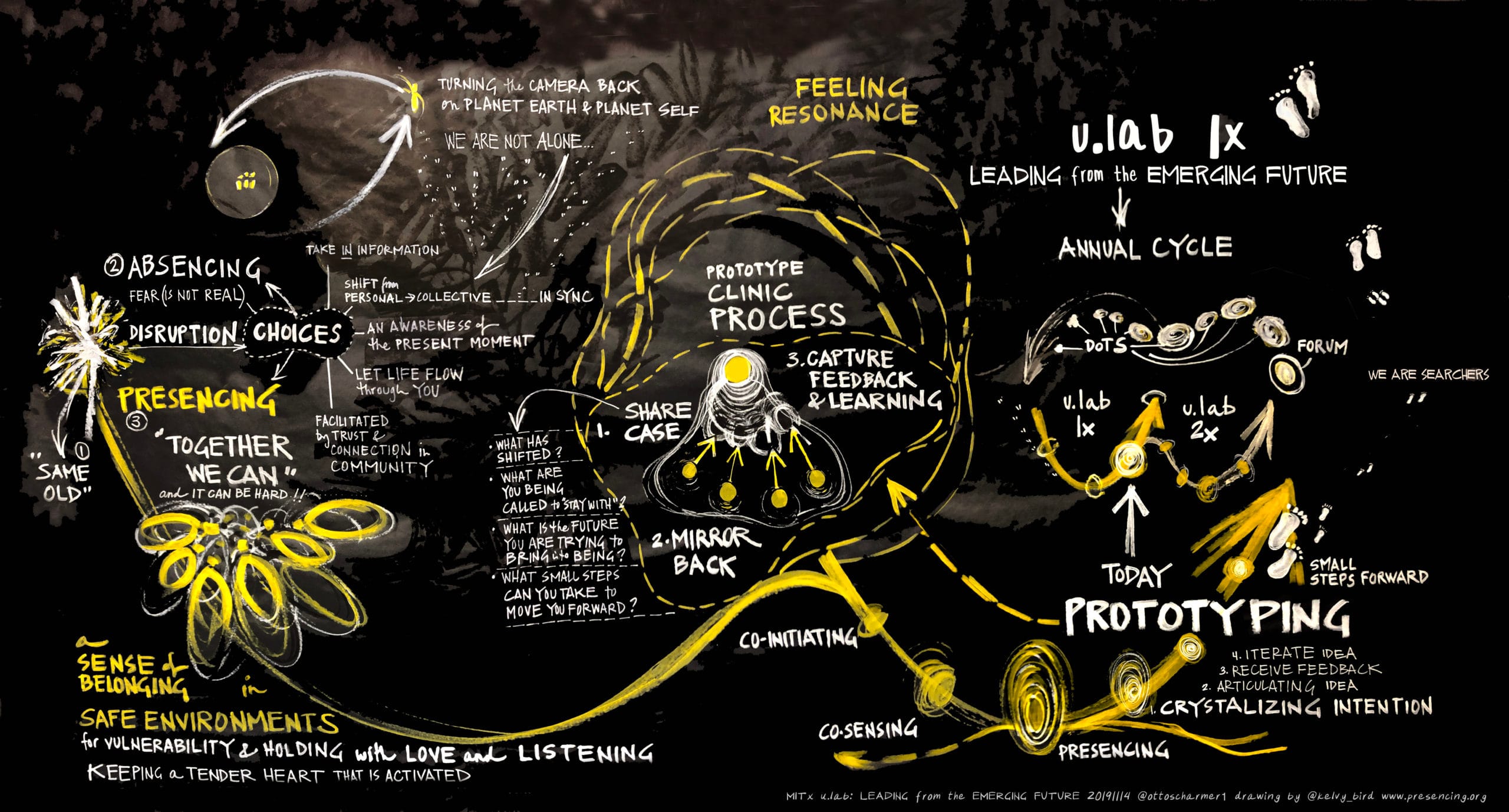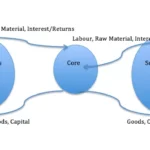Understanding Absencing: Reconnecting with the Present Moment
Do you ever feel like you’re just going through the motions? Like you’re physically present, but your mind is miles away? In the realm of Theory U, this state of disconnection is known as “absencing,” and it’s surprisingly common. It’s a state of autopilot, a detachment from what’s happening both around and within you. This isn’t simply daydreaming; it’s a deeper disconnect that can significantly impact our relationships, our work, and our sense of self. Imagine a meeting where everyone is physically present, but their minds are elsewhere—some on their phones, others lost in thought. The energy is low, ideas are stagnant, and no one feels truly connected. This is absencing in action—a collective fog that hinders engagement and collaboration.
The Downward Spiral of Absencing
Absencing often follows a predictable, downward spiral. It begins with denial—we may not even recognize our disconnection, dismissing it as mere tiredness. Then comes emotional numbness, a desensitization to our surroundings. We withdraw, both physically and emotionally, becoming less engaged with the world and the people in it. Finally, we may resort to blaming others for this lack of engagement, further fueling the cycle of disconnection.
How Absencing Impacts Focus and Relationships
When we’re absent, our attention suffers. We miss crucial details, struggle to see the big picture, and find it difficult to respond effectively to new situations. This fractured attention also weakens our relationships. Trust erodes, communication breaks down, and collaboration becomes a struggle. It’s challenging to build strong connections when we’re not truly present with each other. Want to address brow ptosis and regain a sense of presence in your appearance? The latest technology is available through AspenHCRHS for effective brow ptosis treatment.
What is Absencing? Decoding the Disconnect
Absencing, a core concept in Theory U, signifies a disconnection not only from the present but also from the emerging future. It’s a closing off of our mind, body, and spirit to potential possibilities. This isn’t always a dramatic vanishing act; it can manifest subtly as denial, emotional numbness (like compassion fatigue), or blaming others. This creates a dangerous cycle: denial leads to desensitization, which deepens the absencing, culminating in blaming others. This erosion of trust can severely damage relationships and hinder effective collaboration. Imagine a team project where one member ignores early warning signs, becomes desensitized to growing problems, withdraws, and ultimately blames others for the failing project.
Stages of Absencing
| Stage of Absencing | Example |
|---|---|
| Denial | “There’s no problem here; everything is fine.” |
| Desensitization | “It’s not a big deal; we’ve dealt with worse.” |
| Absencing Itself | Avoiding meetings, withdrawing from the team. |
| Blaming Others | “If the team had pulled their weight…” |
Recognizing absencing, in ourselves and others, is crucial. This awareness allows us to address disconnections early on, especially within complex social systems where collective effort is key. Theory U posits “presencing” as the antidote—an open, connected state fostering co-creation and engagement with the future. Ongoing research suggests that the ability to shift from absencing to presencing is essential for navigating today’s challenges, whether personal, organizational, or global. This is a dynamic area of study, and our understanding of these concepts is likely to evolve. Where might you be absencing yourself, and how can you cultivate more presence?
Absencing vs. Presencing: Two Contrasting Ways of Being
“Absencing” and “presencing” represent two fundamentally different ways of being, profoundly impacting our experiences. Absencing is a state of detachment—being physically present but mentally and emotionally distant. It’s like being on autopilot, going through the motions without genuine engagement. This can stem from various factors, including boredom, stress, or simply habit. Presencing, conversely, is a state of deep, conscious engagement with the present moment. It’s about being fully present, with focused attention and heightened awareness, connecting with the experience on a deeper level. Some theorists suggest that presencing extends beyond the present, encompassing a connection to the emerging future—an openness to possibilities and subtle shifts, enabling us to anticipate and respond effectively to what’s coming.
Key Distinctions
| Feature | Absencing | Presencing |
|---|---|---|
| Attention | Scattered, detached | Focused, engaged |
| Awareness | Limited, superficial | Heightened, deep |
| Connection | Disconnected, distant | Connected, present |
| Orientation | Past or future | Present and emerging future |
| Impact | Missed opportunities, disconnection | Enhanced experience, connection |
While presencing is gaining traction, research is ongoing. Some experts believe it enhances creativity, decision-making, and relationships. We likely fluctuate between these two states throughout the day. Becoming more aware of these shifts is a valuable step towards cultivating a more present and engaged life. Factors such as stress, emotions, and environment probably influence our ability to be present, an area ripe for further research.
What is Presencing? Connecting to Future Possibilities
Presencing involves tuning into the best possible future and actively bringing that vision into the present. It’s a shift from reacting to the past to proactively shaping the future, opening our mind, heart, and will to new possibilities. Conversely, absencing closes us off, hindering our ability to see, feel, and act effectively. It traps us in reactive mode, potentially causing us to miss valuable opportunities.
The Four Pillars of Presencing
Observe: Pay attention to the present without judgment. Notice what you see, hear, and feel with a neutral perspective.
Sense: Tune into your intuition and gut feelings. These subtle cues often hold valuable insights.
Connect: Open yourself to future possibilities based on your observations and intuitions. Envision the best possible outcome and embrace this vision.
Act: Take inspired action guided by the insights gained. This is how you begin to manifest your envisioned future.
The Benefits of Presencing
Presencing offers numerous potential benefits, including increased clarity and conviction in decision-making, enhanced creativity and innovation, improved relationships, and a more fulfilling life. Research suggests it empowers us to create the future we desire rather than merely reacting to the present.
Presencing vs. Absencing: A Summary
| Feature | Presencing | Absencing |
|---|---|---|
| Mind | Open, receptive, exploring | Closed, judgmental, stuck |
| Heart | Connected, compassionate, empathetic | Disconnected, indifferent, apathetic |
| Will | Proactive, intentional, empowered | Reactive, hesitant, disempowered |
| Focus | Future possibilities, present moment awareness | Past experiences, limitations |
| Outcome | Clarity, creativity, connection | Confusion, stagnation, isolation |
Presencing is an ongoing practice, a muscle that strengthens with use. Ongoing research continues to explore its nuances and effects, and our understanding is likely to evolve. It’s a powerful tool for personal and collective transformation, enabling us to consciously create our future. While interpretations vary, the core idea remains: connecting with our deepest potential and bringing it forth into the world. Absencing, the inverse, represents a closing off of our mind, heart, and will, ultimately hindering our ability to connect with emerging futures. It’s crucial to recognize the patterns of absencing—denial, desensitization, and blame—to actively foster practices of opening, connection, and co-creation. Overcoming absencing is essential for navigating complex social systems and unlocking the transformative potential of collective presence. Addressing this disconnection is not a quick fix but a continuous journey of self-discovery and growth, paving the way for deeper connections, enhanced collaboration, and more meaningful contributions.
- Unlock Elemental 2 Secrets: Actionable Insights Now - April 2, 2025
- Lot’s Wife’s Name: Unveiling the Mystery of Sodom’s Fall - April 2, 2025
- Photocell Sensors: A Complete Guide for Selection and Implementation - April 2, 2025
















